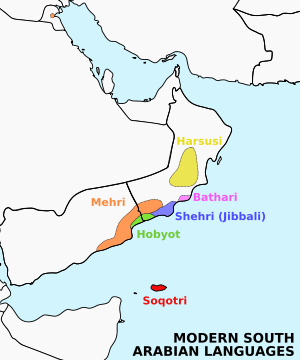Mehri language
| Mehri | |
|---|---|
| Pronunciation | [mɛhri] |
| Native to | Yemen, Oman |
| Ethnicity | Mehri people |
Native speakers | ca. 120,000 (2000–2011)[1] |
| Language codes | |
| ISO 639-3 |
gdq |
| Glottolog |
mehr1241[2] |
 | |
Mehri or Mahri is a member of the Modern South Arabian languages, a subgroup of the Semitic branch of the Afroasiatic family. It is spoken by the Mehri people, who inhabit isolated areas of the eastern part of Yemen and western Oman, particularly the Al Mahrah Governorate.
Mehri and its sister Modern South Arabian languages were spoken in the southern Arabian Peninsula before the spread of Arabic along with Islam in the 7th century CE. It is today also spoken by Mehri residents in Qatar, Somalia and the United Arab Emirates, as well as in Kuwait by guest workers originally from South Arabia.
Given the dominance of Arabic in the region over the past 1400 years and the frequent bilingualism with Arabic among Mehri speakers, Mehri is at some risk of extinction. It is primarily a spoken language, with little existing vernacular literature and almost no literacy in the written form among native speakers.
Dialects
Abu Muhammad al-Hasan al-Hamdani noted that "the Mahra speak a barbarous tongue like foreigners". Elsewhere, Hamdani showed extensive knowledge of Arabian dialects, each of which was rated in its distance from classical Arabic.[3] Given that Hamdani had access to Hebrew and to the various Aramaics from any educated Near Eastern Jew or Christian, if Hamdani could have classified the Mahra language as Northwest Semitic in any form, he would have done so. (It is possible that the Mahra he met were speaking a non-Semitic language, but there is no evidence of such a language; to an Arab, Mehri would sound like a Berber tongue, sharing some traits with Arabic and with Syriac but generally unintelligible.)
Today, Mehri exists in two main dialects, Yemeni Mehri (also known as Southern Mehri) and Omani Mehri (also known as Dhofari Mehri and Nagd Mehri). Omani Mehri is spoken by a smaller population and shows no significant variation within itself, but Yemeni Mehri is further divided into western and eastern dialects.[4]
Phonology
Unlike other South Arabian languages, Mehri 'emphatic' consonants are not simply ejectives but may also be pharyngealized, as in Arabic so it is possible for Mehri to attest to a transition from proto-Semitic ejective consonants to the pharyngealized emphatics that are found in many Semitic languages.[5]
The consonant inventory is as follows:
| Labial | Coronal | Dorsal | Radical | Glottal | |||||
|---|---|---|---|---|---|---|---|---|---|
| laminal | lateral | sibilant | palatal | ||||||
| Nasal | m | n | |||||||
| Occlusive | voiced | b~pʼ | d~tʼ | (dʒ~tʃʼ) | ɡ | ||||
| emphatic | tˁ~tʼ | kʼ | |||||||
| voiceless | tʰ | kʰ | ʔ | ||||||
| Continuant | voiced | ð | l | z | ʁ~q | ʕ | |||
| emphatic | θ̬ˁ~θʼ | ɬ̬ˁ~ɬ̠ʼ | s̬ˁ~sʼ | ʃ̬ˁ~ʃʼ | |||||
| voiceless | f | θ | ɬ̠ | s | ʃ | χ | ħ | h | |
| Rhotic | r~ɾ | ||||||||
| Semivowel | w | j | |||||||
Voiced obstruents, or at least voiced stops, devoice in pausa. In this position, both the voiced and emphatic stops are ejective, losing the three-way contrast (/kʼ/ is ejective in all positions). Elsewhere, the emphatic and (optionally) the voiced stops are pharyngealized. Emphatic (but not voiced) fricatives have a similar pattern, and in non-pre-pausal position they are partially voiced.
The difference in place of the laterals is not clear. It may be that the approximant is denti-alveolar, like the alveolar occlusives, and the lateral fricatives apical, or it may be that the latter are palato-alveolar or alveolo-palatal. The fricatives are typically transcribed ś, etc.
/dʒ/ is only in Arabic loans. It is not clear if the rhotic is a trill or a tap.
Morphology
The following are the personal pronouns of Mahri:
| independent | possessive suffix | |
|---|---|---|
| 1st sg. "I" | hōh | -ī |
| 2nd sg. masc. "you" | hēt | -(a)k |
| 2nd sg. fem. "you" | hīt | -(a)š |
| 3rd sg. masc. "he" | hēh | -(a)h |
| 3rd sg. fem. "she" | sēh | -(a)s |
| 1st du. "the two of us" | kīh | -kī |
| 2nd du. "you two" | tīh | -kī |
| 3rd du. "both of them" | hīh | -hī |
| 1st pl. "we" | nḥah | -(a)n |
| 2nd pl. masc. "you" | tām | -kam |
| 2nd pl. fem. "you" | tān | -kan |
| 3rd pl. masc. "they" | hām | -ham |
| 3rd pl. fem. "they" | sān | -san |
The independent pronouns can also be placed after the genitive exponent (ð-) to convert them into possessive pronouns ("mine" etc).[6]
See also
Notes
- ↑ Mehri at Ethnologue (18th ed., 2015)
- ↑ Hammarström, Harald; Forkel, Robert; Haspelmath, Martin; Bank, Sebastian, eds. (2016). "Mehri". Glottolog 2.7. Jena: Max Planck Institute for the Science of Human History.
- ↑ Abu Muhammad al-Hasan Hamdani, Sifat Jazirat al-'Arab (probably ed. 1884), 134 tr. Chaim Rabin (1951). Ancient West-Arabian. London: Taylor's Foreign Press. p. 43.
- ↑ Rubin, Aaron (2010). The Mehri Language of Oman. BRILL. pp. 1–2. ISBN 9789004182639. Retrieved 24 March 2015.
- ↑ Watson & Bellem, "Glottalisation and neutralisation", in Hassan & Heselwood, eds, Instrumental Studies in Arabic Phonetics, 2011.
- ↑ Rubin 2010, 33.
References
Rubin, Aaron. 2010. The Mehri Language of Oman. Leiden: Brill.
External links
- Examples of Mehri poetry from Hadramut forum
- ELAR archive of Mehri language documentation materials